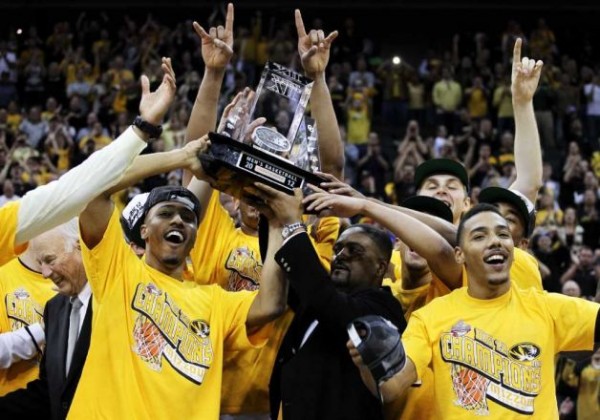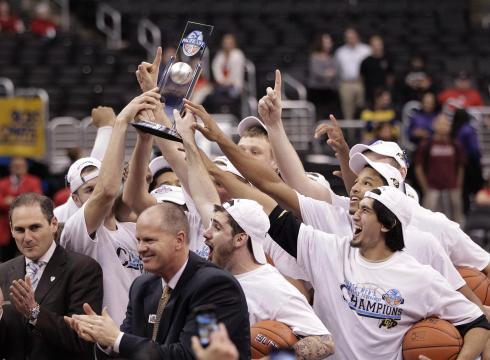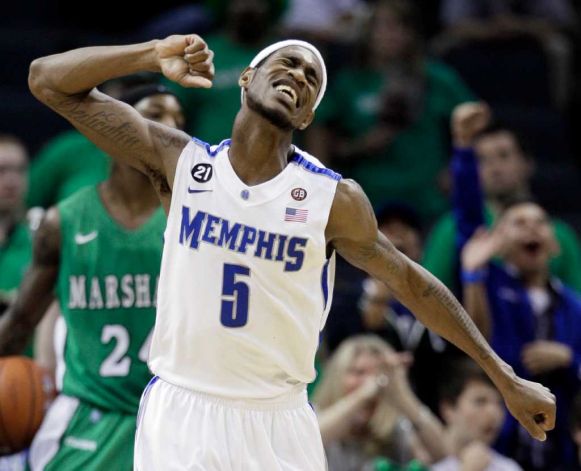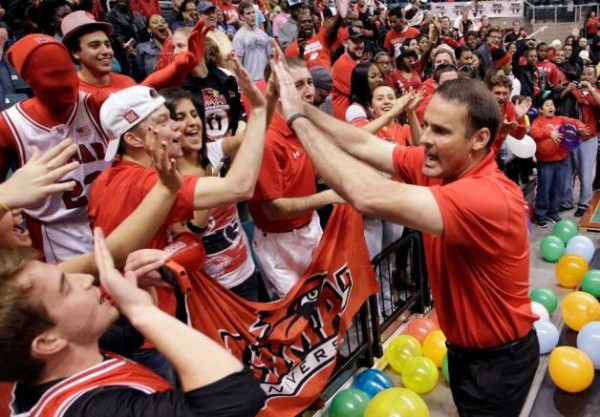Bracket Prep: Missouri, Colorado, Memphis, Vermont, Norfork State & Lamar
Posted by rtmsf on March 10th, 2012As we move through Championship Week, we’ll continue to bring you short reviews of each of the automatic qualifiers to help you fill out your bracket. In this post, we have your America East, Conference USA, MEAC, Southland, Big 12 and Pac-12 conference champions. Here’s what you need to know about these recent bid winners.
Missouri
- Big 12 Conference Champion (30-4, 17-4)
- RPI/Pomeroy/Sagarin = #11/#8/#7
- Adjusted Scoring Margin = +16.0
- Likely NCAA Seed: #1-#2
Three Bruce Pearls of Wisdom.
- It goes without saying that a 30-win season where Missouri won the Big 12 Tournament is already one of the best years in program history. Whether the Tigers end up as a #1 or #2 seed in next week’s NCAA Tournament, the elephant in the room is that despite 24 NCAA appearances and five trips to the Elite Eight (as recently as 2009), Mizzou has never experienced the grandest stage of a Final Four. Whether this is the year that the program finally breaks through depends on a number of factors, but there’s no question that Frank Haith‘s group has tremendous ability, experience and team chemistry. It will take an exceptional opponent to knock this team out of the Dance.
- Missouri’s biggest strength is that it owns the most efficient offense in college basketball, scoring over three more points per 100 possessions than the second best team (Kentucky). In playing a solid non-conference and Big 12 schedule, the only team that proved capable of slowing down the Mizzou attack was Kansas State, who beat the Tigers twice by beating them up on every cut, drive and rebound attempt. The Wildcats held the seasoned group of Marcus Denmon, Kim English, Phil Pressey, and Michael Dixon to 11-36 from the field in the first game, and 19-47 in the second game for a total shooting display of 36.1% (they group shoots 47.4% on the season). If Missouri is to be upset in the NCAAs, it will be by a team who plays a similarly bruising, defensive style — trying to run with this oft-spectacular offensive squad will not work.
- The Tigers’ weakness is its pedestrian defense (ranked #77 in efficiency), but their offense is so explosive that it rarely faces a situation where it has to make a stop to win the game. You might think that its lack of interior size other than Ricardo Ratliffe is another issue, but that’s not been much of a problem for them this season. Ratliffe only fouled out once all year (against Baylor’s huge front line Saturday, incidentally), and with the exception of those two K-State games, the Tigers’ experience and savvy usually allows them to dictate the style and pace of the game. In order to knock this team out, it’s going to take a tremendous defensive effort that can keep up with all of these talented guards. There are only a handful of teams in the country capable of doing that. As a result, this might finally be the year where Missouri faithful experience the wonders of the Final Four.
Colorado
- Pac-12 Conference Champion (23-11, 15-7)
- RPI/Pomeroy/Sagarin = #70/#81/#83
- Likely NCAA Seed: #13-#14
Three Bruce Pearls of Wisdom.
- In a very bizarre Pac-12 season, Colorado on Saturday won the conference’s automatic bid after winning four games in four days against Utah, Oregon, California and Arizona. That they were able to get past the latter three teams, all of whom had designs on an at-large bid to the NCAA Tournament, through equal parts grit and talent. Tad Boyle got some buzz for Coach of the Year in the Pac-12 regular season for good reason — his team lost a considerable amount of talent from last season’s NIT semifinalist, and still was able to remain competitive in a brand new league utilizing a transfer star in Carlon Brown and a corps of athletic wings (particularly Andre Roberson and Spencer Dinwiddie) who are relentless in their pursuit of the basketball.
- The knock on Colorado this year was that they could not win away from the cozy confines of the Coors Events Center in Boulder — the Buffs went 8-1 there in the Pac-12 regular season. But this weekend’s showing in Los Angeles on a neutral floor suggests that they may have started to mature as a team to the point where they can successfully play anywhere. CU’s calling card is its defense — Tad Boyle‘s squad held four opponents this weekend to a mere 53.3 PPG and the reality is that they simply don’t have enough offensive options to play and win games scored in the 70s and above.
- Given that Colorado snuck into the Tournament as a so-called ‘bid burglar,’ they are going to see a powerful team in their first game presuming that the Buffs avoid the First Four matchups. The ideal type of team for them to play would be another offensively challenged squad who might have some trouble with the athleticism that Brown, Roberson, Dinwiddie and company can bring to the table. In the range of seeds CU could possibly see, teams like Wisconsin and Georgetown might offer the best possibility of a big upset.
Memphis
- Conference USA Champion (26-8, 16-3)
- RPI/Pomeroy/Sagarin = #14/#10/#15
- Adjusted Scoring Margin = +14.1
- Likely NCAA Seed: #6
Three Bruce Pearls of Wisdom.
- Memphis has lost just three times in the past two months and Josh Pastner‘s team is looking very much like what pollsters were expecting when they voted the Tigers as preseason Top 10 in the country. Everything is clicking for Memphis, which completely clobbered all three of its opponents in the C-USA Tournament. The championship game was an 83-57 blowout over surging Marshall. The Tigers are expecting freshman stud Adonis Thomas to play more significant minutes in the Big Dance as he continues to recover from injury, adding another weapon to an already loaded arsenal. This is a team that struggled in the non-conference and therefore will not likely receive a strong seed, making it a giant sleeper in any bracket it heads to. Nobody wants to see Memphis in their pod on Sunday.
- Memphis is loaded with talent, and Will Barton‘s transformation from talented guard to do-it-all star has fueled this team’s resurgence. Barton, the runaway C-USA Player of the Year, is having an outstanding season. He averages 18.1 points, 8.1 rebounds, 3.0 assists, 1.4 steals, and 0.7 blocks per game while shooting a fantastic 51.1% from the field. He had 18/13 in the tourney finals and is one of the most versatile players in the country that also can create his own shot at any time. He still sometimes struggles with forcing the issue and trying to do too much, but it wasn’t a problem against conference foes. He’s joined by a bevy of talented athletes, all of whom are capable of having big games. Sophomore Tarik Black has become more reliable inside and shoots 68.6% from the field, one of the best in the nation. Joe Jackson is one of the fastest players you’ll find with the ball in his hands, and he too has improved his decision-making throughout the year.
- Memphis has the potential to be a serious bracket buster in the NCAA Tournament. The Tigers probably can’t receive a seed any higher than #5 for their poor non-conference results. But all of those tough games and losses to Michigan, Georgetown (twice), Louisville, and Murray State have made this team tougher. They are top-30 in the country in both offensive (110.7) and defensive (92.9) efficiency. Their 49.4% field goal percentage ranks fourth in the nation and opponents shoot 38.4%, ninth-best defensively. No team has a bigger positive gap in shooting percentages. Of course, there are inefficiencies for this team, though, that were exposed in the non-conference. Memphis is not a strong rebounding team and ranks #222 in rebound percentage. The Tigers also commit a lot of fouls and are susceptible to mistakes against teams that are strong against high pressure defense. It will be fascinating to see where Memphis ends up in the brackets and if they get shafted with any seed worse than a #6. In any event, Memphis is a sleeper team capable of a Final Four run, but could run into early trouble against opponents that are strong with the ball. For example, the Tigers lost twice to Georgetown and that would be a nightmare matchup in a potential #6-#3 Third Round game.
Vermont
- America East Champion (23-11, 16-3)
- RPI/Pomeroy/Sagarin = #140/#127/#149
- Likely NCAA Seed: #16
Three Bruce Pearls of Wisdom –
- Vermont is back in the NCAA Tournament for the second time in three years, seven years removed from its #13-#4 upset victory over Syracuse. This year’s team, however, is not going to have the luxury of as strong of a seed. The Catamounts are looking at a #16 seed and perhaps could be headed for the First Four matchups next week. Nonetheless, UVM had a great year capped off by the upset of #1 seed Stony Brook in the America East finals on Stony Brook’s home floor. Vermont is 0-5 against the RPI top-100 this year but was able to hang close against strong teams like Harvard, South Florida, and Iona in the non-conference. The Catamounts finished the season strong, winning 14 of their last 15.
- With an interesting combination of veterans and youngsters, Vermont’s leading scorer is freshman guard Four McGlynn, who comes off the bench. Matt Glass is the only senior that plays significant minutes and he’s second in scoring. Brian Voelkel has fascinating numbers for this team as he leads the Catamounts in assists, rebounding, and steals as a sophomore forward and yet he only averages 4.8 points per game. He contributes more rebounds (8.6) and assists (5.2) per game than he does points. Four different players like to shoot the three with McGlynn and Glass both around 40%. Lacking interior athletes, nobody on Vermont averages more than 0.5 blocks per game.
- Vermont held Stony Brook to a paltry 29% field goal shooting in Saturday’s title game, and defense has been the Catamounts’ calling card all season. Their 94.8 season-long defensive efficiency nearly and 40.8% opponent field goal shooting both nearly crack the top 50 in the country. They rebound fairly well (52.1%) and play at a slow pace (63.8 possessions per game). This team plays the kind of style that could give an elite team fits, but it lacks the athletes and playmakers to really give itself a chance at an upset. It would be a shocker if Vermont gave a #1 seed a run for its money. We may see the Catamounts in the First Four, where they could be in for an interesting matchup against another unheralded auto-bid winner.
Norfolk State
- MEAC Champion (25-9, 16-3)
- RPI/Pomeroy/Sagarin = #132/#213/#182
- Adjusted Scoring Margin = -0.1
- Likely NCAA Seed: #16
Three Bruce Pearls of Wisdom.
- Norfolk State is headed to its first NCAA Tournament in program history after hanging on to beat Bethune-Cookman in the MEAC finals. The Spartans had a solid overall record, but losing nine games against the #317 strength of schedule will not impress the committee at all. This team is headed for a #16 seed and possibly a First Four matchup. They did surprise some people very early in the season by defeating Drexel and TCU on back-to-back nights in an early season tournament before falling in the finals to Marquette by just two points. Since then, the Spartans have been off the radar and lost three games to teams of RPI #200 or worse, but they finished strong by winning nine of 10 games.
- Kyle O’Quinn was a dominant big man in the MEAC, averaging 15.9 points, 10.4 rebounds, and 2.8 blocks per game on 58.3% shooting. He’s one of the few players in the country to put up these kind of numbers, and the 6’10” senior will be the target for opposing teams to stop. He’s joined by Pendarvis Williams and Chris McEachin in scoring double figure, as the senior McEachin is a long-range bomber with over 200 three-point attempts this season. After O’Quinn nobody grabs more than four rebounds per night, and no one on the team averages three assists. This is a classic big-man oriented team, which sets up players like McEachin for outside looks.
- As a team, Norfolk State is not very efficient on offense and has a poor assist-to-turnover ratio of 0.78 that is near the bottom 50 nationally. The Spartans make a living at the foul line, one of the many results of pounding the ball inside to O’Quinn for much of the offense. They are an average rebounding team but play pretty solid defense, holding opponents to 40.5% field goal shooting and 0.95 points per possession, both at or near the top 50 in the country. This team should not pose much of a threat to a high seed, but it could surprise and impress some people if O’Quinn does his thing in the paint. The Spartans will hope to avoid being placed in the First Four matchups.
Lamar
- Southland Conference Champion (23-11, 14-5)
- RPI/Pomeroy/Sagarin = #114/#110/#116
- Adjusted Scoring Margin = +4.8
- Likely NCAA Seed: #15-#16
Three Bruce Pearls of Wisdom.
- It was only two-and-a-half short weeks ago when Lamar head coach Pat Knight made national headlines for his post-game rant after a loss to Stephen F. Austin where he accused his players of “stealing scholarship money” for a lack of commitment and effort. Whether it was a planned motivational technique or an unintended consequence of it, his team from that point forward ran off six wins in a row while playing its best basketball of the season. So what changed? Mostly, the defense. In the SFA loss in question, the Lumberjacks lit up the Lamar defense for 54% shooting from the field in a 10-point win. In the six games since, Lamar has held everyone under 45% and three teams in the 30% range, including that same Stephen F. Austin team (30%) in the conference semifinals.
- Defense has to be Lamar’s calling card because the team simply does not shoot the ball very well — only 33.1% from three and 45.5% from two. But if one player is capable of going off, it is senior guard Mike James, a player who made waves last season for his 52-point explosion off the bench. James didn’t have a game resembling that this season, but he was the team’s leading scorer on the year (17.2 PPG) and has been hot during the Cardinals’ recent streak (21.5 PPG). Anthony Miles and Devon Lamb are also capable scorers in the backcourt for Pat Knight, but the squad will have serious trouble against any team with size. The starting lineup runs 6’0″, 6’1″, 6’1″, 6’5″, and 6’6″. Gulp.
- Lamar played Kentucky, Ohio State, and Louisville in the pre-conference season, and were drilled by all three due largely to that lack of size inside. Given that the Cardinals are likely to end up facing off against a #1 or #2 seed, they’re going to be in happy-to-be-there mode, but if there were a team that they’d have the best shot against it might be Missouri with the Tigers’ lack of a strong inside game as well. Of course, slowing down the hyperactive Mizzou defense would create a whole other host of problems, but if James got hot and Missouri wasn’t hitting their jumpers, who knows?

















































Lorenzo Romar was the Pac 12 Coach of the Year not Tad Boyle as the synopsis and photo caption say.